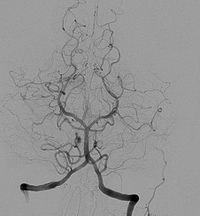
Photo from wikipedia
Purpose The objective of this study was to assess the efficacy and safety of transradial access for diagnostic angiography and interventional neuroradiology procedures. Methods This was a retrospective analysis of… Click to show full abstract
Purpose The objective of this study was to assess the efficacy and safety of transradial access for diagnostic angiography and interventional neuroradiology procedures. Methods This was a retrospective analysis of a single-center experience based on 225 patients attended between August 2015 and October 2019, in which transradial access was used for diagnostic angiography and endovascular interventions. Ultrasound-guided access was done at the level of the forearm or anatomical or snuffbox (distal transradial access). Conventional forearm transradial access was done in 179 procedures (right, left and bilateral in 169, 5 and 5, respectively), while distal transradial access was done in 46 cases (41 right and 5 left). Primary outcome measures included successful catheterization, need to change access, or technical complications. Results In the group of 131 diagnostic angiographies, the technique success rate was 100% to target the right vertebral artery, 97% for the right internal carotid, 93.5% for the left internal carotid, 82% for the left vertebral artery, and 100% for both common and external carotid arteries. All patients were discharged within 2–4 h after the procedure. A total of 94 interventional procedures were performed, including aneurysms in 39 cases, stroke in 34, and other procedures (carotid stents, arteriovenous malformations, carotid-cavernous fistula) in the remaining 21. The overall technical success in both diagnostic angiographies and interventional procedures was 97.7%. In four cases of diagnostic angiography and in 1 intervention, it was necessary to switch from transradial access to transfemoral access. Three cases of hematoma related to the access site were recorded. Conclusions In our experience, transradial access is an alternative approach for diagnostic angiography and neuro-interventions.
Journal Title: Interventional Neuroradiology
Year Published: 2020
Link to full text (if available)
Share on Social Media: Sign Up to like & get
recommendations!